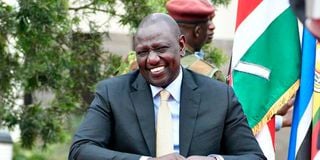Premium
Fulfilling ambitious election pledges tough juggling act for President-elect

President-elect William Ruto. He must now deliver on his pledges to Kenyans.
What you need to know:
- Ruto's ultimate test will be how to balance the promises with the country’s economic reality, choked as it is by high cost of living and a huge national debt.
His win in the August 9 presidential election affirmed by the Supreme Court, President-elect William Ruto must now deliver on his pledges to Kenyans.
His ultimate test will be how to balance the promises with the country’s economic reality, choked as it is by high cost of living and a huge national debt.
Top on his ‘to-do’ list will be dealing with rising commodity prices that pushed the inflation rate to 8.5 per cent in August, the highest level in five years.
The President-elect criticised the government for high cost of food, inputs and other commodities just weeks ago; the big test for him now is how he deploys his strategies to lower prices.
Address these prices
That includes the cost of maize flour that still retails at over Sh200 per 2kg packet, and which his manifesto addressed.
The President will have to address these prices as he considers internal and external factors that have kept the prices high.
Most difficult months
The Kenya National Bureau of Statistics (KNBS) last week reported that Kenyans endured one of the most difficult months in a decade in August as rent and the prices of food, water, electricity, gas, detergent and other household commodities rose by up to 38 per cent compared with 2021.
The price of maize flour, for instance, increased by 38 per cent in August compared with the same month last year, maize by 36 per cent, soap by 36 per cent, kerosene by 30 per cent, sugar by 23 per cent and rice by 16.5 per cent.
Cost of living, therefore, is among the top issues Dr Ruto must deal with to appease poor Kenyans on whose needs he campaigned for the presidency. And, while he strives to control the cost of living, the President-elect will be balancing the measures he takes with government plans that are already underway.
The Kenya Revenue Authority (KRA) has proposed a 6.3 per cent excise duty adjustment on products including fuel, motorcycles, alcohol and Sim cards to align it with this year’s inflation rate.
“In exercise of the powers conferred by Section 10 of the Excise Duty Act, 2015, the commissioner-general adjusts for inflation the specific rates of duty set out in the Schedule hereto in accordance with the formula specified in Part 1 of the First Schedule to the Act with effect from the October 1, 2022 and takes into account the average inflation rate for the 2021/2022 financial year of 6.3 percent,” KRA Commissioner-General Githii Mburu stated in a public notice last week.
Kenya’s inflation
Since February, Kenya’s inflation has risen from 5.08 per cent, crossed the Central Bank of Kenya’s (CBK) red mark of 7.5 per cent in June (7.91 per cent), and hit 8.53 per cent in August.
The KRA measures will not only raise product prices but also take effect at just the time the National Treasury plans to end the fuel subsidy programme that has prevented prices from rising further. The Treasury’s move is intended to meet an International Monetary Fund (IMF) condition for allowing Kenya to access its loans.
Going by the latest review of fuel prices by the Energy and Petroleum Regulatory Authority (Epra) for the period August 15 to September 14, if the subsidy is eliminated, fuel prices will retail at highs of Sh215 (super petrol), Sh206 (diesel) and Sh202 (kerosene).
Fuel prices affect commodity prices because of reliance on it for transportation and manufacturing and its cost largely reflects in the cost of living. This means the government will have to control fuel prices if it intends to keep the cost of living in check.
But the fuel subsidy is also an expense for the government, which runs on a deficit. In the first half of the year, Kenya spent Sh71.2 billion on fuel subsidy, reflecting a monthly average of Sh11.8 billion.
Dr Ruto’s other headache will be implementing some of the promises he made to voters while balancing them with the reality of existing government plans and the fiscal position.
School feeding
For instance, in his manifesto, the incoming President promised to bridge the current teacher shortage of 116,000 within two financial years and to create a one-year paid national internship programme for all students graduating from teachers, technical, medical colleges and universities.
He also pledged to double the amount of money allocated to the school feeding programme to cover four million children. But the current budget for the education sector in the 2022/23 budget is Sh513.8 billion and does not take his promise into account.





